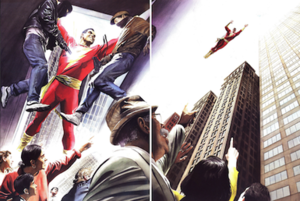A superpower is a special or extraordinary superhuman ability that is greater than what is considered normal. Superpowers are typically displayed in science fiction and fantasy comic books, television programs, video games, and films as the key attribute of a superhero. The concept originated in American comic books and pulp magazines of the 1930s and 1940s, and has gradually worked its way into other genres and media.[1]

Definition edit
There is no rigid definition of a "superpower." In popular culture, it is often associated with unusual abilities such as flight, superhuman strength and speed, invulnerability or psionics. However, it can also describe natural abilities that reach the peak of human potential, such as advanced intelligence or weapon proficiency.[2][3][4]
Generally speaking, superheroes like Batman and Iron Man may be classified as superheroes even though they have no actual superhuman abilities beyond their exceptional talent and advanced technology. Similarly, characters with superhuman abilities derived from artificial, external sources, like Green Lantern's power ring and Tony Stark's Iron Man armor may be described as superpowers, but the wearer is not necessarily superhuman.
In fiction and fantasy, superpowers are often given scientific, technological, pseudoscientific, or supernatural explanations. They come from sources such as magic, technology, or the character's own physiological nature (being an alien, a supernatural being, or a mutant).[2][5]
In manga and anime edit
Superpowers are a commonly used concept in Comics, manga and anime, particularly in the shonen genre. They are often featured in popular manga, comics and anime such as Dragon Ball Z, Saint Seiya, YuYu Hakusho, One Piece, Black Clover, Naruto, Fullmetal Alchemist, Bleach, Code Geass, Fairy Tail, Hunter × Hunter, Attack on Titan, and My Hero Academia.[6]
The types of powers featured vary from series to series. Some, such as Dragon Ball and Fullmetal Alchemist, feature many different characters who have the same types of powers. Others, like One Piece and Bleach, feature characters with a wide range of different powers, with many powers being unique to only one or a few characters.[6]
In Animation edit
Superpowers are commonly used in animated television.
In shows such as Ben 10, American Dragon: Jake Long and Danny Phantom, young protagonists are bestowed with transformative powers which lead them to live a double life. Winx Club and He-Man and the Masters of the Universe feature characters who adventure in fantastical worlds which put their inherent superpowers to the test. In Teenage Mutant Ninja Turtles, Road Rovers and Street Sharks, the characters' superpowers are the result of being transformed into anthropomorphic animals (either from animals or humans), combined with combat training.
Other examples include: Biker Mice from Mars, Toxic Crusaders, Samurai Pizza Cats, Loonatics Unleashed, Darkwing Duck Disney's Gargoyles, Drak Pack, Ghostforce, El Tigre: The Adventures of Manny Rivera, The Mighty B!, Three Delivery, Teamo Supremo, Mummies Alive, Super Robot Monkey Team Hyperforce Go!, The Real Adventures of Jonny Quest, Totally Spies!, Code Lyoko, Storm Hawks, Zevo-3, Chop Socky Chooks, Butt Ugly Martians, and Kung Fu Dino Posse.
In Live Action TV Series edit
Superpowers feature in subgenres of tokusatsu, a form of television characterised by heavy use of special effects. This is embodied by the franchise Super Sentai, known for Mighty Morphin Power Rangers, and its counterpart Kamen Rider.
In Western television, superpowers are often depicted in adaptations of comic books. However, drama series such as Heroes and Misfits are original to television. They use superpowers to heighten the conflicts of otherwise ordinary characters, without strong ties to other superheroic tropes such as codenames or costumes.
References edit
- ^ "The Golden Age Of Comics". www.pbs.org. Retrieved January 11, 2018.
- ^ a b Lovece, Frank (July 16, 2008). "The Dark Knight". (movie review) Film Journal International. Archived from the original on November 7, 2014. Retrieved February 5, 2009.
Batman himself is an anomaly as one of the few superheroes without superpowers…
- ^ "Top 100 Comic Book Heroes". IGN. 2011.
- ^ "Superhero | Definition of Superhero by Merriam-Webster". Merriam-webster.com. March 22, 2016. Retrieved March 26, 2016.
- ^ Gesh, Lois H.; Weinberg, Robert (2002). "The Dark Knight: Batman: A NonSuper Superhero" (PDF). The Science of Superheroes. John Wiley & Sons. ISBN 978-0-471-02460-6. Archived (PDF) from the original on November 6, 2015.
- ^ a b "Superpowers Characters | Anime-Planet". www.anime-planet.com. Retrieved 2016-07-13.
External links edit
- 8 Super Powers, an online Wired Magazine article on how certain superpowers might work
- The Physics of Superheroes, by James Kakalios- a book examining how the powers of several comic book characters would work if they were real.